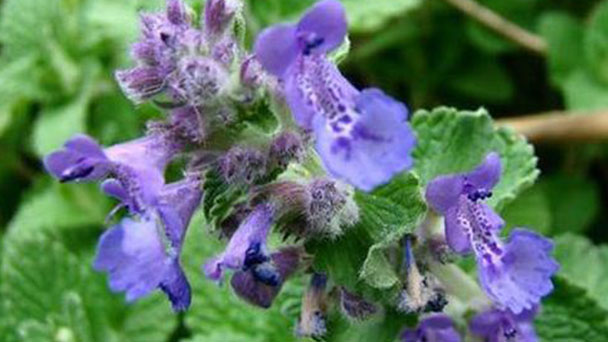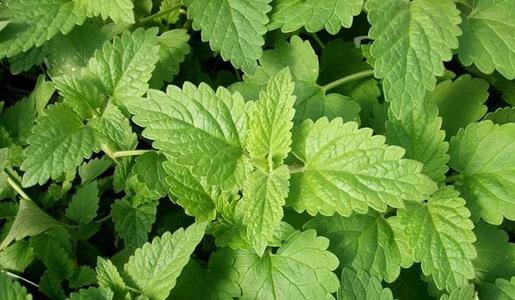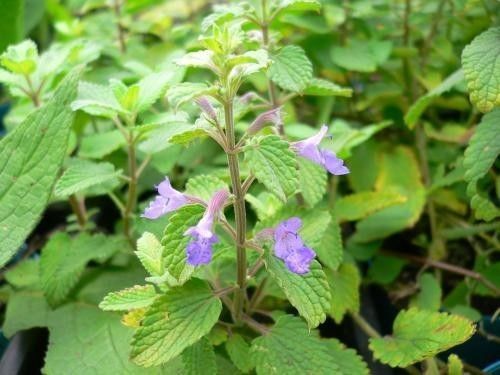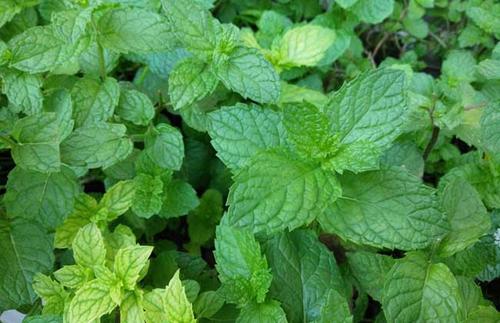Catnip profile
Written by Maggie
Feb 22 2021

Catnip is lamiaceae, perennial plants. Catnip leaves are yellowish green, stem square microbands purple, yellow white cross section, tassel slightly black purple yellowish green, flavor, warm, non-toxic, strong fragrance.
Catnip picture

Catnip morphological characteristics
Catnip stem is strong, base lignified, much branched, 40-150 cm tall, base sub tetragonal, distally obtuse tetragonal, shallow grooves, white pubescent. Leaves of Catnip are ovate to triangular heart-shaped, 2.5-7 cm long, 2.1-4.7 cm wide, apex obtuse to acute, base cordate-truncate, margin coarsely crenate or dentate, herbaceous, yellowish green above, very short bristles, slightly whitish below, pubescent but more densely on veins, lateral veins 3-4 pairs, oblique ascending, slightly concave above, hump below;Petiole 0.7-3 cm long, thin.
Inflorescence of Catnip is cymose, axillary lower part, upper part of the composition of continuous or intermittent, relatively loose or very dense terminal branch panicle, cymes dichasiform branches; Bracts of Catnip are leaflike, or distally small and lanceolate, bracts, bracteoles subulate, minute. The Calyx of Catnip is tubular, ca. 6 mm long, 1.2 mm in diameter, white pubescent outside, only calyx teeth sparsely bristled inside, teeth conical, 1.5-2 mm long, posterior teeth longer, calyx enlarged urceolate after anastomosis, longitudinal ribs very clear. Corolla of Catnip is white, purple point on the lower lip, white pilose on outside and inside in the throat pubescent, about 7.5 mm long, tube very fine, ca. 0.3 mm, the sudden expansion in hypanthium into throat wide, crown canopy two lip, short upper lip, ca. 2 mm long, 3 mm wide, apex shallowly concave, lower lip 3 crack, lobes suborbicular, ca. 3 mm long, ca. 4 mm wide, base cordate, margin with coarse teeth, lateral lobes circular crack flake. Stamens of Catnip are hidden, filaments flattened, glabrous. Style of Catnip is linear, apex 2-lobed. Disk of Catnip is cup-shaped, lobes conspicuous.
Ovary of Catnip is glabrous. Nutlets are ovate, a few trigonal, grayish-brown, ca. 1.7 mm long, ca. 1 mm diameter.
Catnip growth habit
Catnip has a strong adaptability and likes sunshine. Catnip grows in a warm and humid environment with lax requirements on soil. Generally, the soil can be planted, but it is better to grow on loose and fertile soil. Seeds are easy to germinate, germination is not strict to the temperature requirements, seeds in 15~20℃ to germinate, the appropriate temperature for growth is 20~25℃, seedlings can withstand the low temperature of about 0℃. Catnip is resistant to high temperature and cold, but freezing damage may occur below -2℃. Continuous cropping is avoided.
Catnip requires moist soil at the seedling stage to avoid drought and water shortage. Seedling like dry environments, rain and more growth is poor.
The distribution of Catnip
Catnip distributes in Xinjiang, Gansu, Shaanxi, Henan, Shanxi, Shandong, Hubei, Guizhou, Sichuan and Yunnan provinces; From central and southern Europe through Afghanistan, eastward all the way to Japan, the Americas and southern Africa is wild. The type specimens were collected from Europe.
Catnip propagation methods
Catnip is usually propagated by sowing.

Catnip growing methods
Thinning singling
When the seedling height of Catnip is 6~10 cm, there have been dense weak seedlings. When the height of the seedlings is 10~15 cm, according to the row spacing of 10~15 cm, leave 2~3 seedlings for planting. If there is a lack of seedlings, the large seedlings and strong seedlings should be transplanted with soil. It is best to choose cloudy days for Catnip transplanting, and avoid the strong sunshine. When transplanting as much as possible with the original soil, after filling seedlings to water in time, in order to help the seedlings survive.
Hoe weeding
Intertillage and weeding is a key measure for Catnip growth and development. It is mainly to loosen the soil, improve the ground temperature, regulate soil moisture and eradicate weeds, so as to promote root development and ensure the robust growth of seedlings. When the seedling is about 5 centimeters high, loosen the soil with a small hoe, lacerating the land can prevent root injury. Catnip seedling period tillage to highlight the "early, shallow, thin" three words: "early" is to point out that seedlings after the timely tillage; "Shallow" refers to the depth of tillage can not exceed 5 centimeters, in order to prevent the injury of Catnip roots, seedlings, soil moisture;" Fine" it is to point to achieve depth when ploughing is consistent, soil is loose finely broken.
After Catnip into life for a long time, it is also necessary to often plow and weed, keep the soil in the field free of weeds, once every 20 days, or depending on the specific situation, because of the inconvenience of plowing, so pay attention to weeding, or appropriate plow 1~2 times, generally, it is inconvenient to loosen the soil after sealing.Loose soil should be shallow, so as not to hurt the roots.Intertillage should be carried out when the soil moisture is moderate.
Fertilizer irrigation and drainage
Catnip seedling stage requires more nitrogen fertilizer, in order to promote the stalk strong ear, should be appropriate topdressing phosphorus and potassium fertilizer. When the height of the seedling is 15~20 cm, sprinkle some chemical fertilizer along the line, 10~15 kg of topdressing urea per acre, 25~40 kg of cake fertilizer. Seedling period of Catnip should be often watered to facilitate growth. After the drought resistance of the adult plant, Catnip can no longer be watered, but in summer, there is no rain for a long time, and the soil moisture content is below 8%. When the Catnip is wilting, it should be watered lightly, and the amount of watering should not be too large each time. Catnip is most afraid of waterlogging during this period. If there is too much rain, the water in the field should be drained in time to avoid causing disease. When the seedling height of Catnip is 20~25 cm, add potassium chloride 10 kg, open the ditch to apply, after applying soil. When the seedling height is 30 cm or more, 60 kilograms of decoction cake fertilizer per mu, and can be matched with a small amount of phosphorus, potassium fertilizer. Catnip enters the late growth stage in summer, when field management is generally not carried out and natural growth is allowed, which can inhibit reproductive growth and is conducive to nutritional growth and improve yield and quality.
Harvesting and processing
Stems and leaves of Catnip should be harvested in summer when booting but not heading, and mustard ears should be harvested in autumn when 50% of seeds are mature and 50% are still flowering. After the dry dew is selected, the whole Catnip is cut with the sickle to dry in the shade, which is the whole wattle. Catnip ears are picked and dried. The rest of the aboveground part is harvested and dried from the base of the stem, which is called Catnip. In the harvest of medicinal materials, it is necessary to select and retain seed Catnip, and then harvest the seeds when they are fully mature, and dry them in the semi-shade and semi-light places. After drying, thresh them, remove the stem and leaves and other impurities and collect them.
Catnip main value
Medicinal value
The wind; Nourish. Through rash; Stop the bleeding. The main cold fever;Have a headache.Eye itching;Cough; Sore throat;Measles; Carbuncle swollen; Sores scale; Nosebleed. Vomiting blood. Bloody; Ren; Postpartum hemorrhage. For colds, headaches, measles, rubella, sores.Fried charcoal for blood in stool, leakage, postpartum hemorrhage. Dissolve the surface of the wind, through the rash, eliminate sores, hemostasis.For colds, measles, bleeding, bleeding, epistaxis.
Edible value
Catnip has a strong aroma and is mainly served as a vegetable from the tender stems and leaves. Catnip is rich in aromatic oil, with the highest content of leaves, delicious taste, but also insecticidal sterilization, raw food can be cooked, but the salad is more, generally the tender tip as the summer seasoning, is a pollution less, health care spicy vegetables with high economic benefits, very promising development.

Latest Updated
- Benefits of Bugleweed - 7 Science-backed Health Benefits
- Bugleweed Dangers & Side Effects - Is It Poisonous?
- How to Plant Evergreen Trees - What You Should Know
- When to Plant Evergreens - Grow Guide for Evergreen Trees
- 12 Wonderful Evergreen Shrubs for Your Garden
- 12 Popular Evergreen Plants with Pictures for Beginners
- When And How To Prune A Lilac Bush Like a Pro
- How to Grow & Care for Lilac Vine (Hardenbergia Violacea)
- Japanese Lilac Tree (Syringa Reticulata) Care & Propagation Guide
- Shumard Oak Pros and Cons - What to Know
Popular Articles
- Winter maintenance of Antirrhinum Majus
- How to Grow Terminalia Mantaly Tree
- How to Grow and Care for Crossostephium Chinense
- How to grow Antirrhinum Majus in spring
- Peristeria Elata (Dove Orchid) Profile: Info & Care Guide
- Underwatered Snake Plant (Sansevieria Trifasciata) - Signs And How To Fix
- How to Care for Brazilian Jasmine Plant (Mandevilla Sanderi)
- How to Grow & Care for Graptopetalum Purple Delight in Summer
- Rosa Chinensis (China Rose): Plant Growing & Care Tips
- How to Care for Baby Sun Rose (Aptenia Cordifolia)